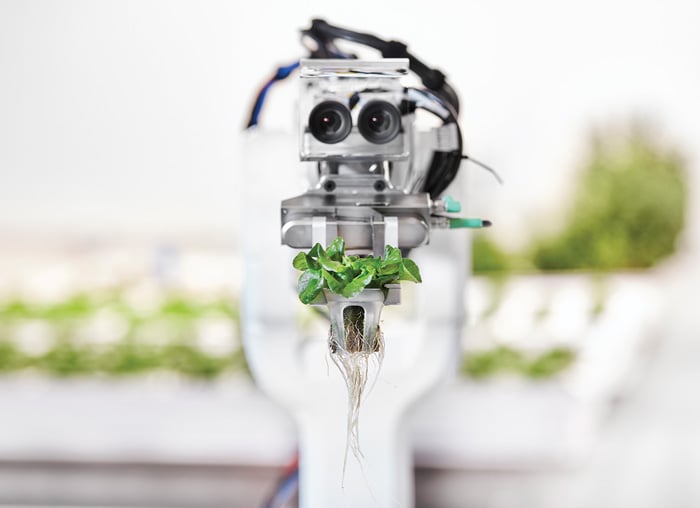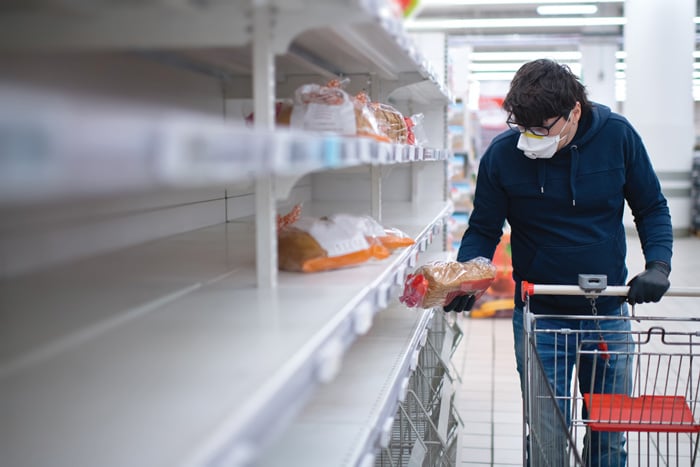
A Vision of the Food System—2045
What are the challenges that will face the food system in 25 years? Here’s a look at some of those challenges and the advances that will be necessary to ensure sufficient resilience.
Article Content
If international initiatives to mitigate climate change, population health, and wealth distribution fall short, there is high potential for 2045 to be a very challenging point for the food system. The Lloyd’s Register Foundation’s report (2019) reveals a roadmap for global food safety. This report considers the potential advances and challenges facing the food system in 2045. It takes into consideration the value of food safety and food security in a food and beverage industry where the experience and behavior of all global consumers are key determinants of our future. The report identifies three core areas that require future effort and investment:
• education and training in developed and developing countries,
• traceability in the food supply chain and development of a broad range of technologies to make food more traceable and, therefore, safer for consumers, and
• investment in aquaculture and seafood production for greater food safety and sustainability.
In this article, we look into the future to predict the potential impacts of climate change, advancement of digital technologies, and new farming strategies on the food system and attempt to identify where resilience currently exists and how this can be built on to ameliorate future crises.
Impacts of Climate Change
By 2045 global climate change impact could have disrupted everything we currently consider to be a normal part of lifestyle. In an ever more interconnected world, the disruption would be felt globally as we have previously shown by our research on the global food system (Martindale et al. 2020a). Poverty-stricken or low-income nations, which were close to sea level in the early 21st century, are likely to have succumbed to catastrophic sea floods and tsunamis. The impact and risks of climate change on dryland agriculture are already being addressed in Gulf states, and this has raised the crucial questions of access to food and equality with respect to future distribution of agri-production (Zurayk et al. 2011).
Of course, food supply has often been a politically driven resource; in the early 1970s, the trading of wheat between the United States and USSR was a political masterpiece of intrigue (The Great Grain Robbery) (Wikipedia). One of the authors (Wayne Martindale) met Earl Butz, President Richard Nixon’s negotiator and agricultural secretary, at Purdue University in 2001. Those wheat negotiations required in-depth knowledge of international supply chains using the technology of the 1970s, namely Landsat Satellite sensing of wheat failures in the USSR. The issues involved characterize many of the pressures and fears we see today; the removal of wheat trade restrictions in 1981 was highlighted by President Ronald Reagan as one of the key contributing factors to the eventual Glasnost and Perestroika.
Trade in agricultural products depends on high quality agricultural land, and in 2045 the availability of such land could be a fraction of what it is today due to the variability of weather resulting in drought, hail damage to crops, and winds that increase soil erosion and loss of soil fertility. While regions adapt to new arable conditions and practices, they will face significant challenges in tackling the impact of weather-induced catastrophes that were previously once-in-a lifetime events.
The time to start strategic planning of agricultural production for the future food system is now, and while it has already begun, a new sense of immediacy in our approach is required (Lipper et al. 2014). Heat waves that were once unexpected may not follow seasonal projections and will result in major health sector impacts that are focused on the most vulnerable, including the elderly and infirm. Such impacts are likely to be regularly reported in mainstream media, and it is not too much of a leap to envisage that by 2045, traffic mega-queues of stationary smart/digital vehicles (powered down to reduce speeds because of increasing car deaths in mainland Europe) could be caused by drivers losing consciousness in response to heat exhaustion.
Without intervention, mass animal extinctions will continue and whole ecosystems will decline and become extinct; for example, the Great Barrier Reef could become significantly depleted or lost completely (United Nations 2019). By 2045 there could be no more living reefs, and unique Mediterranean biodiversity will be lost. The danger of assuming that industrial systems operate without any interaction with ecosystems and biodiversity is evident with the emergence of new food safety risks created by foodborne zoonotic pathogens (mostly viral, some bacterial). Risks of new zoonoses are related to changes in regional climates, new animal migrations, and different consumption behaviors, which not only affect human life directly but also native species of plants and fauna.
Digital Technologies
Food fraud could become commonplace in countries and food supply chains that have not adopted the advanced control mechanisms provided by blockchain (distributed ledger technology) (Martindale et al. 2018). Our current regulatory focus is on the first and last link in the blockchain due to risk displacement, but the blockchain platform could allow many manual tasks to become automated, such as obtaining new material specification, self-invoicing (you invoice your supplier with your purchase), self-ordering (you order your own customer demands), and abolition of payment terms as all procurements are reconciled upon material receipt as well as the VAT mechanism. This all holds much promise and it highlights the current inadequacies in delivering transparency and protecting against food fraud.
By 2045 patterns relating to food safety, quality, and legality could be identified through artificial intelligence (AI) “watchers and sentinels” within the blockchain platform. These systems auto-calculate mass balance between business material transfers; digital twin micro modeling as well as rolling carbon charges are examples of AI watchers and sentinels. Deploy-ment of these AI methods will increase the “headspace” or “bandwidth” within the supply chain and decrease the need for direct human resources accordingly. This will permit focus on more value-adding activity, such as human interaction and system optimization in the mid part of this century.
Data sharing between organizations (including regulators) could be almost fully transparent in 2045 apart from the very few data sets that are imperative to the organization’s unique selling point (USP) or intellectual property. This sharing of data facilitates robust decision-making processes and allows for concessions and deviations to be made known and accounted for within the supply chain. Data can be shared in this system, both up and downstream, which permits substantial reduction in the “bullwhip effect” (increasing swings in inventory in response to shifts in customer demand along the supply chain), which in 2045 may account for around 9% of total food waste, reduced from 50% in 2025. This would be the result of AI technologies calculating demand and supply functions, merging multiple data sets that are bespoke, and eradicating food waste. Furthermore, AI learning could be pooled into a meta-system, which would enable different systems to learn from each other and share meta-data learnings to further enhance the supporting systems. The development of robotics will advance and become commonplace, especially in blockchained countries. Manual labor would be rare to nonexistent unless required in a particular niche area that provides a USP. Robotics in 2045 will be proven to achieve high quality standards in relation to food production without the inherent food safety risks, associated human operator health and safety challenges, and financial costs. This will create the need for radically different skill sets and knowledge bases than those currently required.
Urban Farms
In 2045 many towns and cities could have their own vertical hydroponic farms, which would ensure a fresh supply of local produce to the community, thereby reducing significant amounts of carbon emissions and increasing local fruit and vegetable consumption with a positive effect on community nutrition and health. This approach is also more affordable, with less distribution, reduced pests, and reduced energy balance for production. Nutrition, access, and affordability are improved, but the way in which we obtain food and beverages will completely change. For wealthy individuals with a high demand for animal protein, factory-grown meats will provide an alternative protein delivery system mitigating concerns regarding animal welfare or traditional animal-borne zoonoses. As for access to high quality agricultural land, we must make sure this does not promote the current global food system where “meat is only for the minted.” Distribution of goods and people is likely to change radically, and digital technology is likely to be so well integrated or “fused” that a National Transport Service (NTS) is possible. By 2045 private vehicle ownership (business and residential) could be very rare and not a daily requirement. A fleet of NTS vehicles might include electric-automated carriers, freight carriers, trams, trains, and even short-distance aircraft, which may be able to reach all areas of the country.
Fish Farming
Our aquatic environment has also been heavily impacted by climate change, resulting in migration of species, new pathogens, and new hosts for parasites. Although wild sea stocks for historically popular fish, such as pollock, cod, seabass, tuna, haddock, etc., are currently significantly depleted, they will be in early recovery in 2045, mainly due to the establishment of methods (in combination with genetic modification [GM] technology) for large-scale commercial coastal farming of these species. Among the remaining commercial farming entities, coastal farming of fish will utilize holistic GM technology, from the species of fish to the feed types and nutritional algae additives for enhanced omega-3 levels. In 2045 this could be humanity’s biggest success story in maintaining and growing food security across the planet.
Building Resilience
Our world has fundamentally changed since the start of the 21st century; a combination of vested interests, short-term policy views, and poor stewardship is changing the face of the planet. However, by 2045 human ingenuity and worldwide collaboration have great potential to reverse many of these trends and to increase the stability of societies—following decades of mass migration due to commercial, political, and environmental pressures. This has potential to build a healthier, more equitable planet and sustainable food systems for future generations. Current media coverage often portrays an industry under pressure, leading to calls to rethink broken food supply chains.
There is no doubt that the restrictions on food supply placed on families and individuals who were at risk before COVID-19 are now even greater, resulting in calamitous states of health and well-being. However, there is a need to examine how the food industry is responding to the crisis and most importantly, to bring a sense of proportion to some of the supply problems. Accuracy of information is crucial and AHDB Market Insights has been leading the way in providing data on food system resilience. Retail shopping increased by 20% in the United Kingdom in the four-week period up until March 22, 2020, during which period supply chains absorbed a meteoric shock but also showed resilience to the increased pressures (AHDB 2020). Effort is now needed to identify where resilience is greatest and to locate critical points that can fail.
Conclusions
Future-proofing is more than possible in an industry that knows how to implement innovation and agility, and it is our duty as experts to identify where actions need to be embedded to improve resilience.
Our own research is beginning to identify critical control points that can enhance resilience in food systems (Martindale et al. 2020b). We have only discussed some of the potential future outcomes for the food supply chain based on decisions and policies made today. With the global population expanding to 10 billion by mid-century, we need to take actions today to invest in tomorrow.
This article was first published in the June 2020, Volume 34, No. 2, issue of Food Science & Technology published by the Institute of Food Science & Technology (IFST) and is reproduced here by kind permission of IFST.
REFERENCES
AHDB. 2020. “An extraordinary month in grocery.” https://ahdb.org.uk/news/consumer-insight-an-
extraordinary-month-in-grocery.
Lipper, L., P. Thornton, B. M. Campbell, et al. 2014. “Climate-smart agriculture for food security.” Nat. Clim. Change. 4, 1068–1072.
Lloyd’s Register Foundation. 2019. “Foundation report reveals roadmap for global food safety.” https://www.lrfoundation.org.uk/en/news/foresight-review-food-safety/.
Martindale, W., T. Hollands, M. Swainson, et al. 2018. “Blockchain or bust for the food industry?” Food Sci.
Technol. 33.
Martindale, W., M. Swainson, and S. Choudhary. 2020a. “The Impact of Resource and Nutritional Resilience on the Global Food Supply System.” Sustainability 12, 751.
Martindale, W., L. Duong, and M. Swainson. 2020b. “Testing the data platforms required for the 21st century food system using an industry ecosystem approach. Sci. Total Environ. 137871.
United Nations. 2019. “UN Report: Nature’s Dangerous Decline ‘Unprecedented’; Species Extinction Rates ‘Accelerating.” https://www.un.org/sustainable
development/blog/2019/05/nature-decline-unprecedented-report/.
Wikipedia. “Great Grain Robbery.” https://en.wikipedia.org/wiki/Great_Grain_Robbery.
Zurayk, R., J. Chaaban, and A. Sabra. 2011. “Ensuring that potential Gulf farmland investments in developing countries are pro-poor and sustainable.” Food Secur. 3: 129–137.









